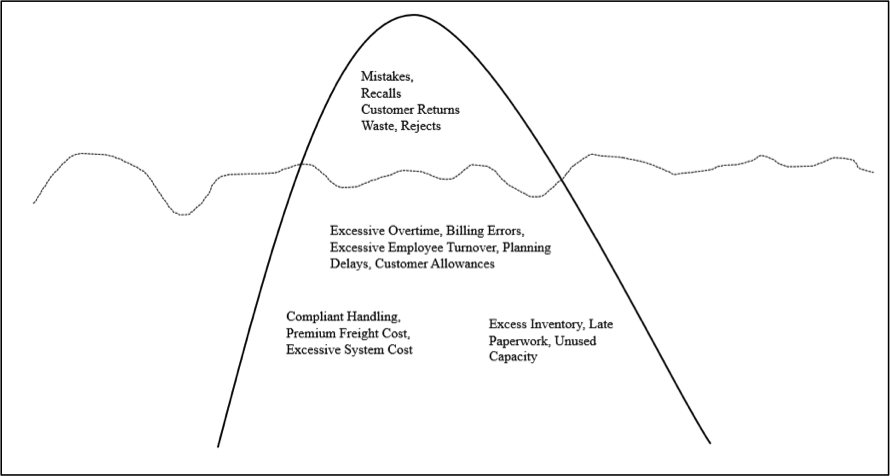
Six Sigma as a Vehicle to Reduce Cost of Poor Quality (COPQ)
The Six Sigma Challenge
Six Sigma emerged as a problem-solving methodology in an effort to reduce variation in processes and minimize defects. Six Sigma can be defined as “ a business improvement strategy used to improve business profitability, to drive out waste, to reduce costs of poor quality and to improve the effectiveness and efficiency of all operations to meet or even exceed customers’ needs and expectations.” (Coronado and Antony 2002). Since its inception at Motorola in the 1980s, Six Sigma faced a number of barriers. Among these barriers are lack of top management support, lack of its understanding among staff, lack of data and the failure to link it to financial benefits. Consequently, many projects failed at launch as Six Sigma practitioners failed to show how the methodology can impact the bottom line in their organizations. Cost of Poor Quality (COPQ) can present an opportunity to justify a Six Sigma project and support its launch.
Understanding COPQ and COQ
Money matters! Organisations are continuously under pressure to reduce their operating costs and increase their revenues. The challenge is to reduce costs while enhancing quality levels and customer satisfaction. Not doing things right the first time has a direct negative impact on the bottom-line (Antony & Banuelas 2002). This direct impact on a company’s bottom line makes of COPQ a vital metric to track. However, for many organisations COPQ is hidden from view and goes unnoticed, making the job of quality professionals more challenging.
While COPQ was addressed by Juran in his first book on quality control in 1951, it was first introduced by Feigenbaum in 1944, while he was working with General Electric Company. Feigenbaum devised a system where costs related to product failures and inspection costs were presented to management, showing the impact of poor quality on the bottom line (Harrington 1999b). Feigenbaum categorised COQ into four main categories: external failure costs, internal failure costs, appraisal and inspection costs, and prevention costs (Harrington 1999a; Pyzdek and Keller 2010) as shown in Figure 1.
- External failure costs present the most serious costs type to an organisation. This cost occurs when a product or service reaches the customer and is rejected. Examples of this cost are returns, warranty claims, and complaint handling.
- Internal failure costs are the costs that the organisation incurs because of an error or defect that is detected before the delivery to a customer. Examples of this cost are in-process scrap and re-work.
- The appraisal and inspection costs are the costs associated with determining if activities are conducted right every time. Examples are audits and inspection visits.
- Prevention costs may be considered an investment rather than a cost, which is why they are sometimes called ‘Cost Avoidance Investment’. Prevention costs are related to investments that would help the organization do things right the first time. Examples are job and quality related training, process improvement initiatives, or Six Sigma project expenses.
Further, the four COQ catergoris were clubbed into 2 main catergories namley the the cost of good quality and the cost of poor quality.

Many organisations use COPQ as one of their key indicators to measure how well they are faring in quality performance (Harry and Schroeder 2000). Surprisingly, COPQ is largely hidden from view and can be much higher than management expects. In some cases, it may reach 60 per cent of the manager’s area of responsibility’s budget (Harrington 1999a). In the same vein, ASQ estimated these expenses to be 15-25 per cent of the total cost of operations (Defeo 2001). Figure 2 shows the concept of the COPQ iceberg and how the need arises to create visibility for the hidden part of the iceberg. i.e. reveal the costs (Internal and external failure costs) that continuously erode the organisation’s profits (Defeo 2001; Pyzdek & Keller 2003). Once the cost of doing things wrong becomes visible, management will pay attention and take action. This is one of the key objectives of using COPQ.

Figure 2: The Cost of Poor Quality iceberg.
Adapted from (Defeo 2001, p.32)
Merging Six Sigma and COPQ
Many quality initiatives emerged with the stated objectives of improving customer satisfaction and reducing defects and COPQ. It can be argued that these objectives have been embedded in many quality programme ethos. Quality programmes such as Total Quality Management (TQM) and Six Sigma may present opportunities for organisations to achieve the above goals. In an organisation, there is a cost associated with defects, errors, and mistakes. Six Sigma projects are one of the vehicles that can help reduce COPQ (Prashar 2014). Goldsby & Martichenko (2005) suggested that Six Sigma implementation improves profitability by reducing the cost of quality and by enhancing effectiveness and efficiency. More specifically, Six Sigma achieves its cost reductions by reducing process variation and defects. It has been reported in the literature and through various studies that management would be more amenable to approve quality projects such as six sigma if those projects were linked, at the initiation phase, to business objectives and financial benefits, like those identified using COPQ. Success measures for Six Sigma projects include COPQ, Defects per Million Opportunities (DPMO), response time to customer complaints, and process capability (Antony et al. 2007). Aligning COPQ with a process quality level such as a specific sigma level is possible: a world class 6 sigma level process will have COPQ of less than 1 per cent of sales. By contrast, a 3-sigma level process will have a COPQ of 25-40 per cent of sales. This vast variation and associated losses mandate the need to use Six Sigma in processes (Klefsjö et al. 2001). Consequently, Linking Six Sigma projects to financial metrics becomes one of its Critical Success Factors (CSFs).
Using COPQ gives visibility to the identified non-value adding activities or waste costs that usually go unnoticed in organisations. Therefore, in order to build a robust justification for an important Six Sigma project one should use COPQ and present this waste in a language that management will understand and pay attention to. This is the language of dollars (Harrington 1999a; Defeo 2001).
Antony, J. et al. (2007). Six sigma in service organisations: Benefits, challenges and difficulties, common myths, empirical observations and success factors. International Journal of Quality & Reliability Management, 24(3), pp.294–311.
Coronado, R. and Antony, J. (2002). Critical success factors for the successful implementation of Six Sigma projects in organizations. The TQM Magazine, 14(2), pp.92–99.
Crosby, P.P.B. (1979). Quality is free: The art of making quality certain. Signet.
Defeo, J.A. (2001). The Tip of the Iceberg. Quality Progress, pp.29–37.
Goldsby, T. and Martichenko, R. (2005). Lean six sigma logistics: Strategic development. Florida: J. Ross Publishing.
Harrington, H. (1999a). Cost of Poor Quality. International Journal of Strategic Cost Management, 17.
Harrington, H. (1999b). Performance improvement: a total poor-quality cost system. The TQM Magazine, 11(4), pp.221–230.
Harry, M. and Schroeder, R. (2000). The Breakthrough Management Strategy Revolutionizing the World’s Top Corporations. New York: Currency.
Klefsjö, B., Wiklund, H. and Edgeman, R.L. (2001). Six sigma seen as a methodology for total quality management. Measuring Business Excellence, 5(1), pp.31–35.
Prashar, A. (2014). Adoption of Six Sigma DMAIC to reduce cost of poor quality. International Journal of Productivity and Performance Management, 63(1), pp.103–126.
Pyzdek, T. and Keller, P.A. (2010). The Six Sigma handbook : a complete guide for greenbelts, blackbelts, and managers at all levels. Third Edit. McGraw Hill.
Related Articles

Implementing Lean Six Sigma In Healthcare: Benefits, Facts, And 7 Tips For Success
As a Black Belt Lean Six Sigma practitioner, I enjoyed leading and executing…

Should organizations allow customers to complain?
In this globalized world competition is fierce at all levels. Segments…

Six Sigma and EFQM Comparison, Similarities and Differences: A critical analysis by a practitioner
Which is better to use in an organization? Should I use Six Sigma or EFQM…

Outlining Scope of Work Planning Process
In today’s competitive business environment, it is imperative for every…
